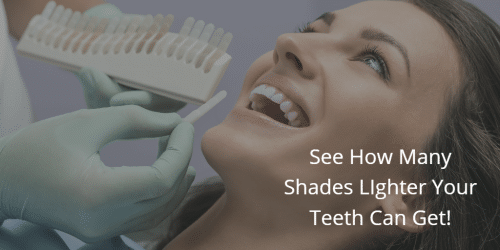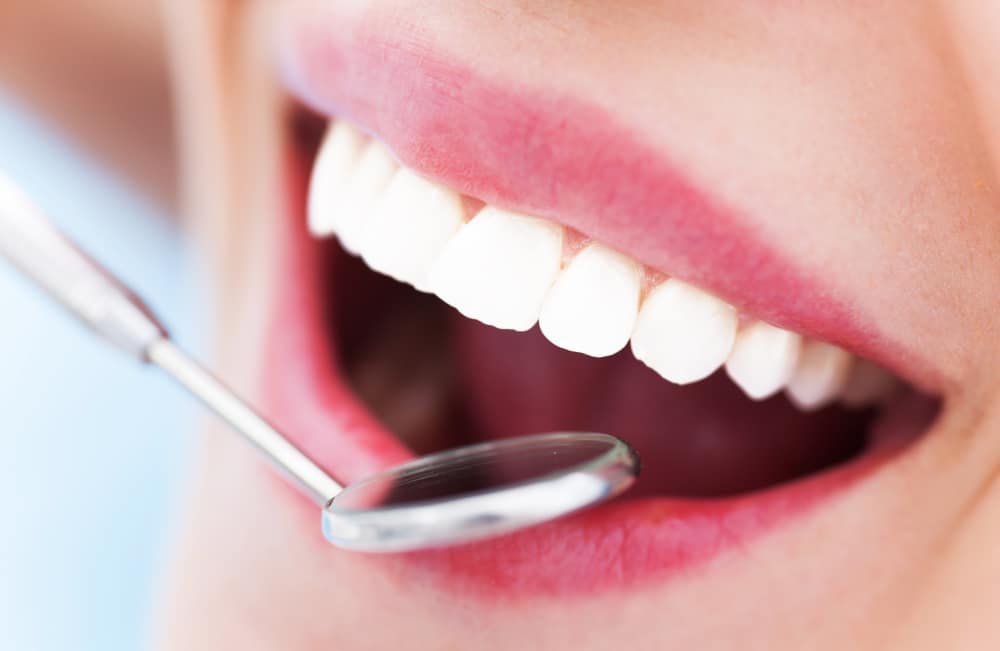General & Cosmetic Dentists Serving Omaha, Bellevue, Lincoln and Nearby Nebraska
Everyone wants a bright, beautiful smile. But lifestyle choices, the foods we eat, and even aging can all take their toll and, over time, cause our teeth to lose their brilliance. Fortunately, today’s convenient at-home teeth whitening solutions offer professional results in the comfort of your own home.

Please contact The Dentists by calling Hillsborough: 402-445-4647, Village Pointe: 402-505-7474, Ralston Square: 402-733-4441, or Dundee: 402-502-5593 to schedule an appointment at one of our convenient Omaha locations to learn about teeth whitening services.
What Causes Tooth Stains?
A myriad of factors play into the way your teeth look. Genetic predisposition plays its part in that some people are simply born with teeth that are naturally brighter than others. But most patients whose teeth are not as white as they would like are simply the victims of modern life. Any of the following can gradually cause your teeth to lose their natural luster:
- Tea and coffee consumption
- Red wine consumption
- Tobacco use
- Treatment with certain antibiotics
While cessation or reduction of any of these causes can slow the staining process, reversal requires a topical bleach such as that available through the cosmetic dentists at The Dentists of Omaha.
How Does At-Home Teeth Whitening Work?
At-home teeth whitening starts with a thorough oral exam to make sure that you’re a good candidate for teeth whitening. Then, we take impressions of your teeth which we use to fabricate custom models of your unique anatomy. Finally, we use these models to develop special whitening trays that are customized just for you.
At home, you fill your personalized tray with our professional tooth whitening gel and place the tray over your teeth. Most patients are asked to wear the tray for several hours per day, and results are usually obvious within one or two weeks. Our many satisfied patients are a testament to just how effective our at-home products are.
What Makes Our Teeth Whitening Better Than Those in the Store?
It may be tempting to simply buy an in-store whitening product the next time you go shopping. But, as with just about everything in life, you get what you pay for. Those drugstore products can never match the results available with professional whitening because of the following:
- The over-the-counter gel is many times weaker than what is available from a dental professional
- Treatment takes much longer for not as strong of a result
- Over-the-counter trays aren’t customized for your unique teeth
- Over-the-counter whiteners can cause sensitivity because they are fit for your teeth
In the end, you’ll end up wasting time and money with over-the-counter whiteners, so save yourself the trouble and learn about our professional treatments today!
Is At-Home Teeth Whitening Safe?
Yes, at-home teeth whitening is very safe when used as directed. Be sure not to misuse or overuse the whitening products. Doing so can result in tooth sensitivity and gum irritation. If you have pre-existing dental conditions, be sure to tell your dentist before starting treatment.

How Long Does It Take To See Results?
Most patients start to see results after they complete a few treatments. However, results will depend on how discolored your teeth are and how often you apply the whitening treatment.
Will It Remove All of the Stains?
Most at-home whitening treatments work well to brighten your smile by several shades. However, you also need to be mindful of the food and drink you consume after treatment. Staining food and drink, such as tomato sauce, coffee, tea, and red juices, should be avoided or consumed through a straw.
How Often Can I Whiten My Teeth at Home?
How often you can whiten at home depends on how discolored your teeth are and the strength of the product. It is always best to follow your dentist’s instructions and not overuse the products. Overuse can cause tooth sensitivity and may damage the tooth enamel.
How Can I Reduce Sensitivity Caused by At-Home Whitening Treatments?
Tooth sensitivity is a common side effect of at-home whitening treatments. Here are some tips to reduce discomfort:
- Use the Right Toothpaste: Switch to a toothpaste designed for sensitive teeth a few weeks before and during the whitening process. These toothpastes contain ingredients like potassium nitrate, which helps block pain signals from your teeth’s nerve endings.
- Limit Whitening Sessions: Follow the instructions provided with your whitening kit as written. Overuse can lead to increased sensitivity. If you experience discomfort, consider reducing the frequency of your whitening sessions.
- Avoid Cold and Hot Foods: After whitening, you may notice more sensitivity to temperature changes. Avoid very hot or cold foods and drinks for a few days following treatment.
- Take Breaks Between Treatments: Give your teeth a rest between whitening sessions so they can recover. This can help reduce sensitivity over time.
What Should I Do if I Experience Irritation From the Whitening Gel?
Irritation from whitening gel can occur if it makes contact with your gums or soft tissues. Here’s what you can do:
- Apply with Care: Apply the whitening gel only to the teeth. Avoid overfilling the trays, as excess gel can seep onto the gums.
- Use a Cotton Swab: After applying the trays, use a cotton swab to remove leftover gel that may have come into contact with your gums.
- Rinse with Salt Water: If irritation occurs, rinse your mouth with a saltwater solution. This can soothe irritation and promote healing.
- Discontinue Use: If irritation persists, discontinue the use of the whitening product. Consult your dentist for more advice.
How Can I Maintain the Results of At-Home Whitening Treatments?
Maintaining your whitening results requires ongoing care:
- Practice Good Oral Hygiene: Brush and floss your teeth regularly to remove plaque and prevent stains from building up.
- Be Wary of Staining Foods and Drinks: Reduce your intake of foods and beverages that can stain your teeth. Examples include coffee, tea, red wine, and berries. If you do indulge, rinse your mouth with water afterward to prevent staining.
- Drink Through a Straw: When drinking beverages that may stain your teeth, use a straw to reduce contact with your teeth.
- Schedule Regular Dental Cleanings: Professional cleanings help remove surface stains. They can also help you maintain your whitening results.
Does Whitening Toothpaste Help Maintain the Results of At-Home Treatments?
Yes, whitening toothpaste can be an effective way to maintain the results of at-home treatments. Here’s how:
- Remove Surface Stains: Whitening toothpaste contains mild abrasives that help remove surface stains. They also prevent new ones from forming.
- Strengthen Enamel: Many whitening toothpastes contain fluoride. Fluoride strengthens your tooth enamel and helps protect against cavities and decay.
- Use Daily: Incorporate whitening toothpaste into your daily oral care routine to brighten your smile. However, do not rely solely on whitening toothpaste, as it does not penetrate deeper stains below the enamel.
Why Choose The Dentists?
Choosing The Dentists ensures a personalized and community-focused dental experience for all patients. With four convenient locations—Hillsborough, Village Pointe, Ralston Square, and Dundee—our team is dedicated to serving the Omaha community with superior dental care.
As proud Nebraskans, we prioritize building strong connections with our patients and providing care that feels both local and accessible. We emphasize listening to our patients' needs and educating them on their dental health. We also strive to make every visit as simple and convenient as possible.
Schedule Your Teeth Whitening Appointment Today
If stained and discolored teeth are affecting how you feel about yourself, it’s time to learn how convenient, at-home whitening treatments can restore your smile and your self-confidence. Please contact The Dentists today by calling Hillsborough: 402-445-4647, Village Pointe: 402-505-7474, Ralston Square: 402-733-4441, or Dundee: 402-502-5593 to arrange your teeth whitening consultation. The Dentists serves Omaha, Bellevue, Lincoln and nearby areas of Nebraska.